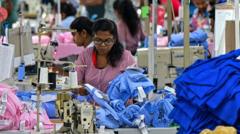Why Are America's Clothing Makers Facing Punishment?

Impact of U.S. Trade Tariffs on Asian Garment Workers
As the clock ticks down to a critical deadline for trade negotiations, a palpable sense of anxiety envelops millions of garment workers across Asia. The looming threat of increased tariffs from the United States poses a significant challenge to their already precarious livelihoods. With a majority of these workers living from hand to mouth, the stakes couldn't be higher. The garment industry, known for its low-wage labor force, is now facing an uncertain future, and the implications could be dire for families who rely on this income.
The U.S. government has recently notified several countries in the region of impending tariff hikes, set to take effect on August 1. This decision follows a 90-day pause intended to allow nations to negotiate better trade deals. Countries like Cambodia and Sri Lanka, heavily reliant on their apparel exports to the U.S., are bracing for a potential economic crisis. The new tariffs, while lower than initially proposed, have done little to quell fears among workers and industry leaders alike.
Understanding the Tariff Structure
The letters sent by President Trump indicated that Cambodia would face a staggering 36% tariff, while Sri Lanka would be subjected to a 30% tariff. Such high rates could cripple the garment industry, which is crucial for both nations' economies. For instance, Cambodia exported over $3 billion worth of apparel to the U.S. last year, a sector that employs more than 900,000 workers. In Sri Lanka, the garment industry directly employs around 350,000 people and generated $1.9 billion in exports in the same timeframe.
Voices from the Ground
The human impact of these trade policies is starkly illustrated through the stories of workers like Nao Soklin, who fears for her family's future. She and her husband, Kok Taok, work long hours in a garment factory in Cambodia, earning a meager income that barely meets their family's basic needs. With two young sons and elderly relatives to care for, the potential loss of their jobs due to tariffs is a heavy burden to bear. "We need our jobs to support our families," she pleads, highlighting the urgency of the situation.
In Sri Lanka, the sentiments echo similarly. Yohan Lawrence, secretary general of Sri Lanka’s Joint Apparel Association Forum, expresses the gravity of the situation, stating that the country is at a significant disadvantage compared to competitors like Vietnam, who are facing lower tariff rates. The urgency to negotiate a better deal is palpable, as leaders from both countries scramble to protect their industries from the looming threat of economic fallout.
Negotiating Tariffs: The Path Forward
As both countries seek to negotiate better terms, the stakes remain high. Cambodia has already received a 13 percentage point concession, while Sri Lanka has managed a 14 percentage point reduction. However, industry leaders remain cautious. They understand that further negotiations will be essential to achieve a more sustainable tariff rate that can safeguard jobs and maintain economic stability.
The Broader Economic Implications
Beyond the immediate impacts on workers, the tariffs also have broader economic implications. The U.S. has long enjoyed the benefits of lower-priced imports from developing countries like Cambodia and Sri Lanka. The imposition of prohibitive tariffs could lead to increased costs for American consumers and businesses, ultimately undermining the very economic relationships that have benefited both parties. Analysts argue that these tariffs overlook the mutual advantages of existing trade agreements.
Furthermore, the strategic rivalry between the U.S. and China complicates matters. As garment-exporting countries find themselves integrated into supply chains reliant on Chinese inputs, they are now tasked with balancing their economic ties with both nations. This juggling act could lead to further instability in the garment sector, already fraught with challenges such as poverty and weak labor rights.
The Gender Dynamics in the Garment Industry
Women comprise approximately 70% of garment workers in these countries, making them particularly vulnerable to the economic fallout from increased tariffs. Many women, like Surangi Sandya in Sri Lanka, voice their fears of job insecurity and potential layoffs. "Companies don't work at a loss," she states, expressing the anxiety that looms over her factory. With wages already low, further reductions or job losses could push families into deeper poverty.
For these workers, the garment factory is often their primary source of income, and the prospect of shutting down operations due to decreased orders is terrifying. Some Cambodian workers are even contemplating illegal migration to neighboring Thailand in search of employment. "Our livelihoods depend on the garment factory," says An Sopheak, illustrating the desperation of those caught in this precarious situation.
Conclusion: The Road Ahead
The impending deadlines for trade negotiations and the threat of tariffs present a complex landscape for garment workers in Asia. With millions depending on the industry for their livelihoods, the outcome of these discussions will significantly impact their futures. The challenges posed by tariffs not only threaten economic stability but also highlight the vulnerabilities faced by workers in low-wage sectors worldwide.
As we look to the future, it is imperative to consider the broader implications of trade policies and the human stories that lie behind them. The stakes are high, and the call for fair and equitable trade practices has never been more pressing. How will nations balance their economic interests with the well-being of their citizens? The answer to this question could determine the fate of millions.
FAQs
What are the new tariff rates for Cambodia and Sri Lanka?
Cambodia will face a 36% tariff, while Sri Lanka will be subjected to a 30% tariff on their apparel exports to the U.S.
How many people are employed in the garment industry in Cambodia and Sri Lanka?
Cambodia's garment sector employs over 900,000 people, while Sri Lanka's garment industry directly employs approximately 350,000 individuals.
Why are tariffs being imposed on these countries?
The U.S. government claims that tariffs are necessary to address trade imbalances and create more reciprocal trade relations.
The future of the garment industry in Asia is uncertain, and the consequences of these trade negotiations will be felt by millions. What actions do you think should be taken to support garment workers during these challenging times? #GarmentIndustry #TradeTariffs #EconomicImpact
```Published: 2025-07-24 00:56:15 | Category: technology



